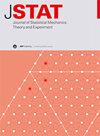用于信号检测和随机遍历性破缺的功能重正化群
IF 1.9
3区 物理与天体物理
Q2 MECHANICS
Journal of Statistical Mechanics: Theory and Experiment
Pub Date : 2024-08-01
DOI:10.1088/1742-5468/ad5c5c
引用次数: 0
摘要
信号检测是数据科学的主要挑战之一。在数据分析中,数据中的信号经常会被噪声干扰。有多种技术旨在从数据中提取相关的自由度。然而,有些问题仍然难以解决。尤其是在信噪比足够小的情况下,几乎连续光谱中的信号检测。本文沿用了最近的文献路线,用场理论方法解决这一问题。以往的分析侧重于代表数据自由度的有效场的平衡波尔兹曼分布。我们有可能在信号探测和对称性破缺之间建立一种关系。在本文中,我们考虑了受所谓 "模型 A "启发的随机场框架,并证明了达到或未达到平衡状态的能力与数据集的形状相关。特别是,通过研究模型的重正化群,我们表明,当数据分布接近马琴科-帕斯图尔定律时,信号足够小时,弱遍历性规定总是被打破。这尤其有助于在信噪比足够小的情况下定义探测阈值。本文章由计算机程序翻译,如有差异,请以英文原文为准。
A functional renormalization group for signal detection and stochastic ergodicity breaking
Signal detection is one of the main challenges in data science. As often happens in data analysis, the signal in the data may be corrupted by noise. There is a wide range of techniques that aim to extract the relevant degrees of freedom from data. However, some problems remain difficult. This is notably the case for signal detection in almost continuous spectra when the signal-to-noise ratio is small enough. This paper follows a recent bibliographic line, which tackles this issue with field-theoretical methods. Previous analysis focused on equilibrium Boltzmann distributions for an effective field representing the degrees of freedom of data. It was possible to establish a relation between signal detection and -symmetry breaking. In this paper, we consider a stochastic field framework inspired by the so-called ‘model A’, and show that the ability to reach, or not reach, an equilibrium state is correlated with the shape of the dataset. In particular, by studying the renormalization group of the model, we show that the weak ergodicity prescription is always broken for signals that are small enough, when the data distribution is close to the Marchenko–Pastur law. This, in particular, enables the definition of a detection threshold in the regime where the signal-to-noise ratio is small enough.
求助全文
通过发布文献求助,成功后即可免费获取论文全文。
去求助
来源期刊
CiteScore
4.50
自引率
12.50%
发文量
210
审稿时长
1.0 months
期刊介绍:
JSTAT is targeted to a broad community interested in different aspects of statistical physics, which are roughly defined by the fields represented in the conferences called ''Statistical Physics''. Submissions from experimentalists working on all the topics which have some ''connection to statistical physics are also strongly encouraged.
The journal covers different topics which correspond to the following keyword sections.
1. Quantum statistical physics, condensed matter, integrable systems
Scientific Directors: Eduardo Fradkin and Giuseppe Mussardo
2. Classical statistical mechanics, equilibrium and non-equilibrium
Scientific Directors: David Mukamel, Matteo Marsili and Giuseppe Mussardo
3. Disordered systems, classical and quantum
Scientific Directors: Eduardo Fradkin and Riccardo Zecchina
4. Interdisciplinary statistical mechanics
Scientific Directors: Matteo Marsili and Riccardo Zecchina
5. Biological modelling and information
Scientific Directors: Matteo Marsili, William Bialek and Riccardo Zecchina

 求助内容:
求助内容: 应助结果提醒方式:
应助结果提醒方式:


